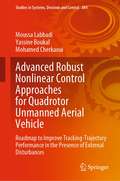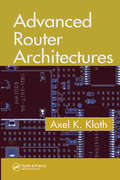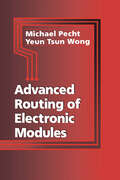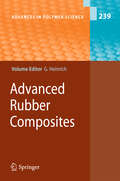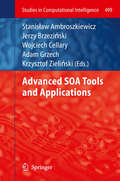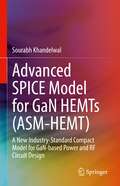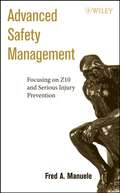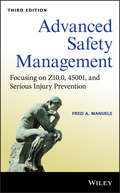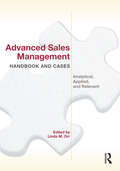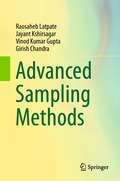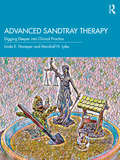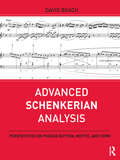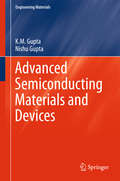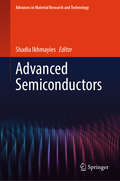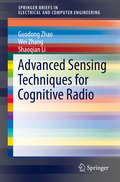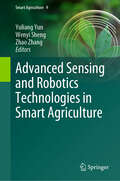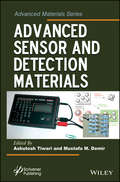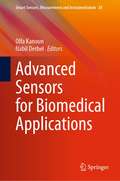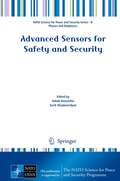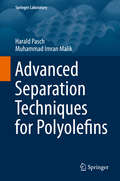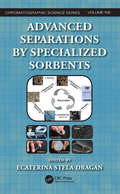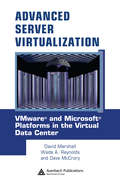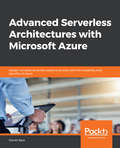- Table View
- List View
Advanced Robust Nonlinear Control Approaches for Quadrotor Unmanned Aerial Vehicle: Roadmap to Improve Tracking-Trajectory Performance in the Presence of External Disturbances (Studies in Systems, Decision and Control #384)
by Moussa Labbadi Yassine Boukal Mohamed CherkaouiThis book studies selected advanced flight control schemes for an uncertain quadrotor unmanned aerial vehicle (UAV) systems in the presence of constant external disturbances, parametric uncertainties, measurement noise, time-varying external disturbances, and random external disturbances. Furthermore, in all the control techniques proposed in this book, it includes the simulation results with comparison to other nonlinear control schemes recently developed for the tracking control of a quadrotor UAV. The main contributions of the present book for quadrotor UAV systems are as follows:(i) the proposed control methods are based on the high-order sliding mode controller (SMC) and hybrid control algorithm with an optimization method.(ii) the finite-time control schemes are developed by using fast terminal SMC (FTSMC), nonsingular FTSMC (NFTSMC), global time-varying SMC, and adaptive laws. (iii) the fractional-order flight control schemes are developed by using the fractional-order calculus theory, super twisting algorithm, NFTSMC, and the SMC.This book covers the research history and importance of quadrotor system subject to system uncertainties, external wind disturbances, and noise measurements, as well as the research status of advanced flight control methods, adaptive flight control methods, and flight control based on fractional-order theory. The book would be interesting to most academic undergraduate, postgraduates, researchers on flight control for drones and applications of advanced controllers in engineering field. This book presents a must-survey for advanced finite-time control for quadrotor system. Some parts of this book have the potential of becoming the courses for the modelling and control of autonomous flying machines. Readers (academic researcher, undergraduate student, postgraduate student, MBA/executive, and education practitioner) interested in nonlinear control methods find this book an investigation. This book can be used as a good reference for the academic research on the control theory, drones, terminal sliding mode control, and related to this or used in Ph.D. study of control theory and their application in field engineering.
Advanced Router Architectures
by Axel K. KlothRouters, switches, and transmission equipment form the backbone of the Internet, yet many users and service technicians do not understand how these nodes really work.Advanced Router Architectures addresses how components of advanced routers work together and how they are integrated with each other. This book provides the background behind why these building blocks perform certain functions, and how the function is implemented in general use. It offers an introduction to the subject matter that is intended to trigger deeper interest from the reader. The book explains, for example, why traffic management may be important in certain applications, what the traffic manager does, and how it connects to the rest of the router. The author also examines the implications of the introduction or omission of a traffic manager into an advanced router. The text offers a similar analysis for other router topics such as QOS and policy enforcement, security processing (including DoS/DDoS), and more.This book covers which mandatory and which optional building blocks can be found in an advanced router, and how these building blocks operate in conjunction to ensure that the Internet performs as expected.
Advanced Routing of Electronic Modules (Electronic Packaging)
by Michael Pecht Yeun Tsun WongThe rapid growth of the electronic products market has created an increasing need for affordable, reliable, high-speed and high-density multi-layer printed circuit boards (PCBs). This book presents the technologies, algorithms, and methodologies for engineers and others developing the next generation of electronic products.A vision of the future in advanced electronicsAdvanced Routing of Electronic Modules provides both fundamental theory and advanced technologies for improving routing. Beginning chapters discuss approaches to approximate a minimum rectilinear Steiner tree from a minimum spanning tree and introduce ways to avoid obstacles for routing simple multi-terminal nets sequentially in a workspace. Timing delay, clock skew, and noise control requirements in signal integrity are described as well as computer-aided approaches to managing these requirements in high-speed PCB/MCM routing.Later chapters present the two-layer wiring problem, rip-up and reroute approaches, and parallel routing, including global routing, boundary crossing placement, and detailed maze routing in hardware acceleration. Data structures, data management, and algorithms for parallel routing in a multiple-processor hardware systems are also covered.
Advanced Rubber Composites (Advances in Polymer Science #239)
by Gert HeinrichMorphology-Property Relationship in Rubber-Based Nanocomposites: Some Recent Developments, by A. K. Bhowmick, M. Bhattacharya, S. Mitra, K. Dinesh Kumar, P. K. Maji, A. Choudhury, J. J. George and G. C. Basak; * Rubber-Clay Nanocomposites: Some Recent Results, by Amit Das, De-Yi Wang, Klaus Werner Stöckelhuber, René Jurk, Juliane Fritzsche, Manfred Klüppel and Gert Heinrich; * Surface Modification of Fillers and Curatives by Plasma Polymerization for Enhanced Performance of Single Rubbers and Dissimilar Rubber/Rubber Blends, by J. W. M. Noordermeer, R. N. Datta, W. K. Dierkes, R. Guo, T. Mathew, A. G. Talma, M. Tiwari and W. van Ooij; * Recent Developments on Thermoplastic Elastomers by Dynamic Vulcanization, by R. Rajesh Babu and Kinsuk Naskar; * PTFE-Based Rubber Composites for Tribological Applications, by M. S. Khan and G. Heinrich
Advanced SOA Tools and Applications (Studies in Computational Intelligence #499)
by Wojciech Cellary Adam Grzech Stanisław Ambroszkiewicz Jerzy Brzeziński Krzysztof ZielińskiThis book presents advanced software development tools for construction, deployment and governance of Service Oriented Architecture (SOA) applications. Novel technical concepts and paradigms, formulated during the research stage and during development of such tools are presented and illustrated by practical usage examples. Hence this book will be of interest not only to theoreticians but also to engineers who cope with real-life problems. Additionally, each chapter contains an overview of related work, enabling comparison of the proposed concepts with exiting solutions in various areas of the SOA development process. This makes the book interesting also for students and scientists who investigate similar issues.
Advanced SPICE Model for GaN HEMTs (ASM-HEMT): A New Industry-Standard Compact Model for GaN-based Power and RF Circuit Design
by Sourabh KhandelwalThis book discusses in detail the Advanced SPICE Model for GaN HEMTs (ASM-HEMT), a new industry standard model for GaN-based power and RF circuit design. The author describes this new, standard model in detail, covering the different components of the ASM GaN model from fundamental derivations to the implementation in circuit simulation tools. The book also includes a detailed description of parameter extraction steps and model quality tests, which are critically important for effective use of this standard model in circuit simulation and product design. Coverage includes both radio-frequency (RF), and power electronics applications of this model. Practical issues related to measurement data and parameter extraction flow are also discussed, enabling readers easily to adopt this new model for design flow and simulation tools.Describes in detail a new industry standard for GaN-based power and RF circuit design;Includes discussion of practical problems and their solutions in GaN device modeling;Covers both radio-frequency (RF) and power electronics application of GaN technology;Describes modeling of both GaN RF and power devices.
Advanced Safety Management
by Fred A. ManueleProvides guidance to managers, safety professionals, educators and students on having operational risk management systems that meet the requirements of Z10.Emphasizes Management Leadership and Employee Involvement, the most important section in Z10, with particular reference to contributions that employees can make.A new provision was added to Z10 on Risk Assessment which along with Avoidance of Human Error is addressed.Revised and expanded coverage of Management of Change and The Procurement ProcessNew chapters cover Macro Thinking - The Socio-Technical Model; Safety Professionals as Culture Change Agents; Prevention through Design, and A Primer on System Safety
Advanced Safety Management Focusing on Z10 and Serious Injury Prevention
by Fred A. ManueleLearn how to improve the effectiveness of safety and health management systems by adopting ANSI Z10 provisions and avoid serious workplace injuries. This reference addresses specific provisions, including risk assessment methods and prioritization; applying a prescribed hierarchy of controls; implementing safety design reviews; and more. It also explains how to integrate best practices for the prevention of serious injuries in your workplace. See how implementing the ANSI Z10 standard can enhance your company's productivity, cost efficiency, and quality.
Advanced Safety Management: Focusing on Z10.0, 45001, and Serious Injury Prevention
by Fred A. ManueleEstablishes sound safety management principles and focuses on the revised Z10.0 safety standard, the new 45001 safety standard, and serious injury prevention Filled with updated chapters and information throughout, this book covers the provisions of ANSI/ASSP Z10.0-2019, the American standard for Occupational Health and Safety Management Systems. It expands in detail on the principles for advanced safety management, the content of the revised Z10.0 standard, and the newly adopted international standard, ISO 45001. It also emphasizes the need to reduce the occurrence of serious injuries, illnesses, and fatalities. Advanced Safety Management: Focusing on Z10.0, 45001 and Serious Injury Prevention, Third Edition expands on the material in previous editions and includes several new chapters emphasizing culture, systems design, and incident investigations. Beginning with an overview of ANSI/ASSP Z10.0-2019 and ANSI/ASSP/ISO 45001-2018, it goes on to offer chapters on: Essentials for the Practice of Safety; Human Error Avoidance; Hazards Analyses and Risk Assessments; Three- and Four-Dimensional Risk Scoring Systems; Safety Design Reviews; The Procurement Process; Audit Requirements; The Management Oversight and Risk Tree (MORT); and more. Expands in detail on the principles for advanced safety management, the content of the revised ANSI/AIHA Z10.0. standard and the newly adopted international standard, ISO 45001 New chapters cover the Significance of An Organization's Culture; Fundamental Concepts; and Systems/Macro Thinking Places emphasis on the more prominent risk-based approach in the practice of safety Provides methods to align safety, operational, and financial goals, along with quality and environmental standards Explains the concepts of risk reduction, waste reduction, environmental impact deduction, and Prevention through Design (PtD) Advanced Safety Management is an important book for safety professionals, industrial hygienist, plant managers, OSHA and EPA advocates, students majoring in safety or industrial hygiene, and union leaders.
Advanced Sales Management Handbook and Cases: Analytical, Applied, and Relevant
by Linda M OrrAdvanced Sales Management Handbook and Cases: Analytical, Applied, and Relevant will fill the need in the market for a solid case work, role play, and activity book. It has been written by sales teaching professionals and sales executives. The life experiences of professionals with varied experiences will provide students with a solid foundation for learning. This will give college professors from around the world a better opportunity to ensure quality of learning. The book is intended to be supplemental to any other sales management text on the market, but could be used alone in an advanced sales management or marketing analytics course in which the students already have the base theoretical knowledge. The various cases, role plays, and experiential exercises in this book will follow the same topical structure of other sales management texts so that any sales management instructor can readily adopt this supplemental book. For many of the cases, actual data has been given so that students are required to use and understand analytical software.
Advanced Sampling Methods
by Girish Chandra Raosaheb Latpate Jayant Kshirsagar Vinod Kumar GuptaThis book discusses all major topics on survey sampling and estimation. It covers traditional as well as advanced sampling methods related to the spatial populations. The book presents real-world applications of major sampling methods and illustrates them with the R software. As a large sample size is not cost-efficient, this book introduces a new method by using the domain knowledge of the negative correlation between the variable of interest and the auxiliary variable in order to control the size of a sample. In addition, the book focuses on adaptive cluster sampling, rank-set sampling and their applications in real life. Advance methods discussed in the book have tremendous applications in ecology, environmental science, health science, forestry, bio-sciences, and humanities. This book is targeted as a text for undergraduate and graduate students of statistics, as well as researchers in various disciplines.
Advanced Sandtray Therapy: Digging Deeper into Clinical Practice
by Linda E. Homeyer Marshall N. LylesAdvanced Sandtray Therapy deepens mental health professionals’ abilities to understand and apply sandtray therapy. Chapters show readers how to integrate clinical theory with sand work, resulting in more focused therapeutic work. Using practical basics as building blocks, the book takes a more detailed look at the ins and outs of work with attachment and trauma, showing therapists how to work through the sequence of treatment while also taking into account clients’ trauma experiences and attachment issues. This text is a vital guide for any clinician interested in adding sandtray therapy to their existing work with clients as well as students in graduate programs for the mental health professions.
Advanced Schenkerian Analysis: Perspectives on Phrase Rhythm, Motive, and Form
by David BeachAdvanced Schenkerian Analysis: Perspectives on Phrase Rhythm, Motive, and Form is a textbook for students with some background in Schenkerian theory. It begins with an overview of Schenker's theories, then progresses systematically from the phrase and their various combinations to longer and more complex works. Unlike other texts on this subject, Advanced Schenkerian Analysis combines the study of multi-level pitch organization with that of phrase rhythm (the interaction of phrase and hypermeter), motivic repetition at different structural levels, and form. It also contains analytic graphs of several extended movements, separate works, and songs. A separate Instructor’s Manual provides additional advice and solutions (graphs) of all recommended assignments.
Advanced Semiconducting Materials and Devices (Engineering Materials)
by Nishu Gupta K. M. GuptaThis book presents the latest developments in semiconducting materials and devices, providing up-to-date information on the science, processes, and applications in the field. A wide range of topics are covered, including optoelectronic devices, metal-semiconductor junctions, heterojunctions, MISFETs, LEDs, semiconductor lasers, photodiodes, switching diodes, tunnel diodes, Gunn diodes, solar cells, varactor diodes, IMPATT diodes, and advanced semiconductors. Detailed attention is paid to advanced and futuristic materials. In addition, clear explanations are provided of, for example, electron theories, high-field effects, the Hall effect, transit-time effects, drift and diffusion, breakdown mechanisms, equilibrium and transient conditions, switching, and biasing. The book is designed to meet the needs of undergraduate engineering students and will also be very useful for postgraduate students; it will assist in preparation for examinations at colleges and universities and for other examinations in engineering. Practice questions are therefore presented in both essay and multiple choice format, and many solved examples and unsolved problems are included.
Advanced Semiconductors (Advances in Material Research and Technology)
by Shadia IkhmayiesThis book presents comprehensive reviews on the synthesis, characterization, properties, and applications of advanced semiconducting materials. It explores modern inorganic, organic, and hybrid semiconductors, and semiconductor physics through density functional theory. Topics include morphology-dependent properties in inorganic semiconductors, and methods for tuning the electron transport properties of nanotube semiconductors. Readers will also find discussions on earth-abundant and environmentally friendly chalcogenide nanomaterials for photovoltaics, the use of chalcogenides and oxide semiconductors in photoelectrochemical reactions, and insights into defect formation during ion implantation in diamond and c-BN thin films. A thermomechanical response model for photothermal diffusion waves in rotating magnetized semiconductors is also presented. This book provides readers with a solid foundation in recent developments and current technologies for producing and characterizing semiconductors, as well as theoretical and computational tools.
Advanced Sensing Techniques for Cognitive Radio (SpringerBriefs in Electrical and Computer Engineering)
by Wei Zhang Guodong Zhao Shaoqian LiThis SpringerBrief investigates advanced sensing techniques to detect and estimate the primary receiver for cognitive radio systems. Along with a comprehensive overview of existing spectrum sensing techniques, this brief focuses on the design of new signal processing techniques, including the region-based sensing, jamming-based probing, and relay-based probing. The proposed sensing techniques aim to detect the nearby primary receiver and estimate the cross-channel gain between the cognitive transmitter and primary receiver. The performance of the proposed algorithms is evaluated by simulations in terms of several performance parameters, including detection probability, interference probability, and estimation error. The results show that the proposed sensing techniques can effectively sense the primary receiver and improve the cognitive transmission throughput. Researchers and postgraduate students in electrical engineering will find this an exceptional resource.
Advanced Sensing and Robotics Technologies in Smart Agriculture (Smart Agriculture #9)
by Zhao Zhang Wenyi Sheng Yuliang YunThis book specifically focuses on state-of-the-art advanced sensing and robotic techniques in smart agriculture and comprehensively describes the new knowledge. Significant agricultural technology progress in advanced sensing and robotics technology has been made recently, which has transformed the conventional agriculture to smart and digital agriculture It provides readers take-away knowledge for seed quality detection, specialty crop harvest and sorting robotics, new sensing method for crop nutrient status, and broadband soil dielectric permittivity measurements. All these new technologies have been developed, tested, or practically applied. It is a useful reference for readers in the field of smart agriculture and agriculture robotics.
Advanced Sensing in Image Processing and IoT (Innovations in Multimedia, Virtual Reality and Augmentation)
by Rashmi Gupta, Arun Kumar Rana, Sachin Dhawan, and Korhan CengizThe book provides future research directions in IoT and image processing based Energy, Industry, and Healthcare domain and explores the different applications of its associated technologies. However, the Internet of Things and image processing is a very big field with a lot of subfields, which are very important such as Smart Homes to improve our daily life, Smart Cities to improve the citizens' life, Smart Towns to recover the livability and traditions, Smart Earth to protect our world, and Industrial Internet of Things to create safer and easier jobs. This book considers very important research areas in Energy, Industry, and Healthcare domain with IoT and image processing applications.The aim of the book to highlights future directions of optimization methods in various engineering and science applications in various IoT and image processing applications. Emphasis is given to deep learning and similar models of neural network-based learning techniques employed in solving optimization problems of different engineering and science applications. The role of AI in mechatronics is also highlighted using suitable optimization methods. This book considers very important research areas in Energy, Industry, and Healthcare. It addresses major issues and challenges in Energy, Industry, and Healthcare and solutions proposed for IoT-enabled cellular/computer networks, routing/communication protocols, surveillances applications, secured data management, and positioning approaches. It focuses mainly on smart and context-aware implementations. Key sailing Features: The impact of the proposed book is to provide a major area of concern to develop a foundation for the implementation process of new image processing and IoT devices based on Energy, Industry, and Healthcare related technology. The researchers working on image processing and IoT devices can correlate their work with other requirements of advanced technology in Energy, Industry, and Healthcare domain. To make aware of the latest technology like AI and Machine learning in Energy, Industry, and Healthcare related technology. Useful for the researcher to explore new things like Security, cryptography, and privacy in Energy, Industry, and Healthcare related technology. People who want to start in Energy, Industry, and Healthcare related technology with image processing and IoT world.
Advanced Sensor and Detection Materials
by Ashutosh Tiwari Mustafa M. DemirThe development of sensors at macroscopic or nanometric scales in solid, liquid, or gas phases, contact or noncontact configurations, has driven the research of sensor & detection materials and technology into high gear. The emphasis on detection techniques requires the use of spin crossover organic, inorganic and composite materials and methods that could be unique for sensors fabrication. The influence of length, composition and conformation structure of materials on their properties and the possibilities to adjust sensing properties by doping or adding the side-groups are the starting point of multifarious sensing. The role of inter-molecular interactions, polymer and ordered phases formation, as well as the behavior under pressure, magnetic and electric fields are also important facts for processing of ultra-sensing materials. Advanced Sensor and Detection Materials highlights the key features that aid the design of new sensor and detection materials for a multitude of sensor and detection devices. The senior contributors write on the follow topics:Construction of nanostructuresThe role of the shape in the design of new nanoparticlesAdvances in sensors' nanotechnologyMolecularly imprinted polymer for enantioselective sensing devicesFerrites for high frequency applicationsMesoporous Silica: Making "Sense" of SensorsPorous TiO2-Au/Ag materialsFerroelectronic glass-ceramicsNASICON: Synthesis, structure and electrical characterisationHeavy clay products qualityIonic liquidsDendrimers and hyperbranched polymersTheoretical investigation of superconducting state parametersMicroscopic polarization and thermal conductivity of binary Wurtzite nitridesExperiments techniques and theoretical background to study materialsThe book is written for readers from diverse backgrounds across chemistry, physics, materials science and engineering, medical science, pharmacy, biotechnology, and biomedical engineering. It offers a comprehensive view of cutting-edge research on advanced materials for sensor and detection technology and applications.
Advanced Sensors for Biomedical Applications (Smart Sensors, Measurement and Instrumentation #38)
by Nabil Derbel Olfa KanounThe book highlights recent developments in the field of biomedical sensors with a focus on technology and design aspects of novel sensors and sensor systems. Diagnosis plays a central role in healthcare and requires a variety of novel biomedical sensors and sensor systems. This creates an enormous ongoing demand for sensors for both the everyday life as well as for medical care. Technologies concerning the analysis of human activities as well as for the early detection of diseases are moving into the focus of interest and form the basis for supporting human health and quality of life. As such, the book offers a key reference guide about novel medical sensors and systems for students, engineers, sensors designers and technicians.
Advanced Sensors for Safety and Security (NATO Science for Peace and Security Series B: Physics and Biophysics)
by Ashok Vaseashta Surik KhudaverdyanThis book results from a NATO Advanced Research Workshop titled "Technological Innovations in CBRNE Sensing and Detection for Safety, Security, and Sustainability" held in Yerevan, Armenia in 2012. The objective was to discuss and exchange views as to how fusion of advanced technologies can lead to improved sensors/detectors in support of defense, security, and situational awareness. The chapters range from policy and implementation, advanced sensor platforms using stand-off (THz and optical) and point-contact methods for detection of chemical, nuclear, biological, nuclear and explosive agents and contaminants in water, to synthesis methods for several materials used for sensors. In view of asymmetric, kinetic, and distributed nature of threat vectors, an emphasis is placed to examine new generation of sensors/detectors that utilize an ecosystems of innovation and advanced sciences convergence in support of effective counter-measures against CBRNE threats. The book will be of considerable interest and value to those already pursuing or considering careers in the field of nanostructured materials, and sensing/detection of CBRNE agents and water-borne contaminants. For policy implementation and compliance standpoint, the book serves as a resource of several informative contributions. In general, it serves as a valuable source of information for those interested in how nanomaterials and nanotechnologies are advancing the field of sensing and detection using nexus of advanced technologies for scientists, technologists, policy makers, and soldiers and commanders.
Advanced Separation Techniques for Polyolefins (Springer Laboratory)
by Harald Pasch Muhammad Imran MalikThis Springer Laboratory volume introduces the reader to advanced techniques for the separation and fractionation of polyolefins. It includes detailed information on experimental protocols and procedures, addressing the experimental background of different polyolefin fractionation techniques in great detail. The book summarizes important applications in all major fractionation methods with emphasis on multidimensional analytical approaches. It comprises the most powerful modern techniques, such as high temperature size exclusion chromatography (HT-SEC) for molar mass analysis, temperature rising elution fractionation (TREF) and crystallization analysis fractionation (CRYSTAF) for the analysis of chemical composition and branching, high temperature two-dimensional liquid chromatography (HT-2D-LC), solvent and temperature gradient interaction chromatography (SGIC and TGIC) and crystallization elution fractionation (CEF). Beginners as well as experienced chromatographers will benefit from this concise introduction to a great variety in instrumentation, separation procedures and applications. With detailed descriptions of experimental approaches for the analysis of complex polyolefins, the readers are offered a toolbox to solve simple as well as sophisticated separation tasks. The book starts with an introduction into the molecular complexity of polyolefins - the most widely used synthetic polymers with rapidly growing production capacities. It systematically discusses crystallization based fractionation techniques including TREF, CRYSTAF and CEF and column chromatographic techniques for molar mass, chemical composition and microstructure, as well as the combination of different fractionations in multidimensional experimental setups. This book also includes basic information on the application of high-temperature field-flow fractionation.
Advanced Separations by Specialized Sorbents (Chromatographic Science Series)
by Ecaterina Stela DraganAdvanced Separations by Specialized Sorbents opens a new window into sorbent materials, presenting fundamental principles for their syntheses and adsorption properties. The book presents advanced techniques used to create specialized sorbents with a wide range of functions that can be used to enhance the separation and/or purification of useful bio
Advanced Server Virtualization: VMware and Microsoft Platforms in the Virtual Data Center
by David Marshall Wade A. Reynolds Dave McCroryPresenting practical guidelines and examples, Advanced Server Virtualization emphasizes design, implementation, and management from both a technical and consultative point of view. It features step-by-step guidelines for planning, deployment, installing, configuring, and creating virtual servers. Covering Microsoft Virtual Server and VMware, it addresses platform-specific virtualization features such as virtual machines, hard drives, networking, and resource management. It offers best practices that allow users to avoid common pitfalls and achieve success faster during server virtualization implementations. It also discusses software licensing issues and the cost-benefits of deploying virtual servers.
Advanced Serverless Architectures with Microsoft Azure: Design complex serverless systems quickly with the scalability and benefits of Azure
by Daniel BassThe audience are cloud software engineers with prior experience in Azure or Serverless. They want to learn how to build observable, reliable, available and fault tolerant complex systems using Serverless components. This will allow them to deliver better systems with fewer outages and higher performance than they could achieve previously.
